#Washers for piping systems
Explore tagged Tumblr posts
Text
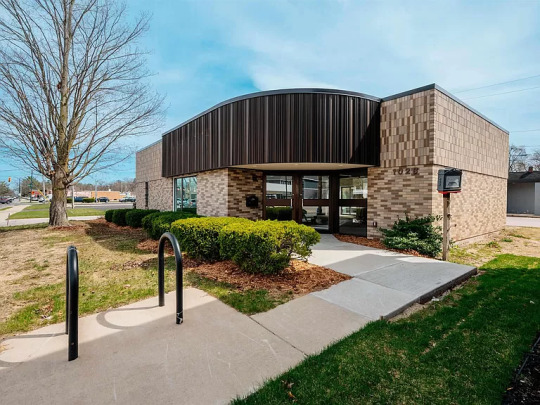
WTH? When I looked at this home, I thought, what is that? A bank? 1961 build in Traverse City, MI w/3bds, 4ba, listed for $795K.

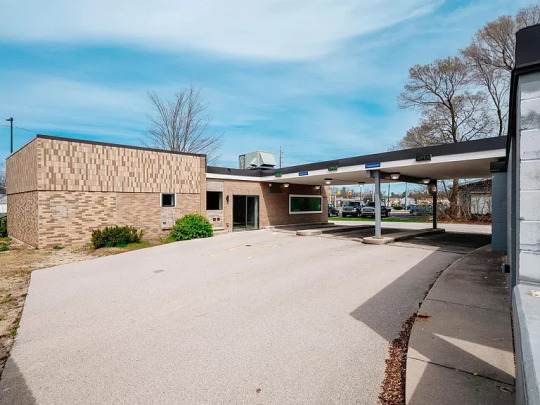
Yep, it's a bank. And, guess what? You get the drive-thru, too. But, they removed the hydraulic system. WTF? You do still have 3 lanes, the open/closed lights and the service window. But, that's not all. Actually, it's a floppy flip- they left a lot of stuff undone.
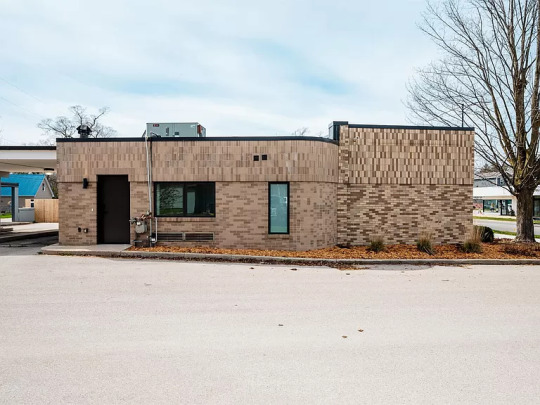


You also get this weird building next to it, where they must've done other banking stuff. But, whatever flipper did this, removed the vault, and that's the best part!

I mean, really. It's still got all the glass bank doors.

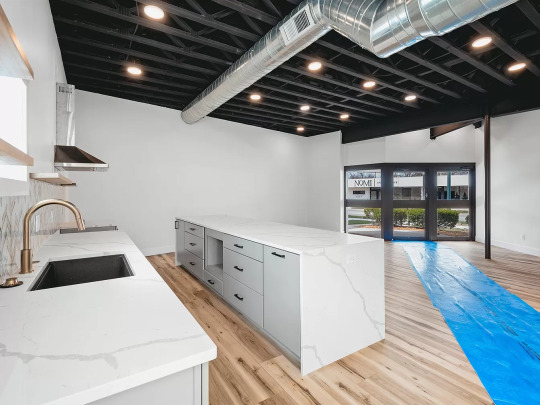
You basically enter the kitchen. Follow the plastic blue road to Munchkin Land.

Hey...a new house and I gotta buy my own appliances? I never saw anything like this. Come on, now. Deal breaker.


The living room or dining room, who knows, wraps around to the bank's former side doors by the drive-in.
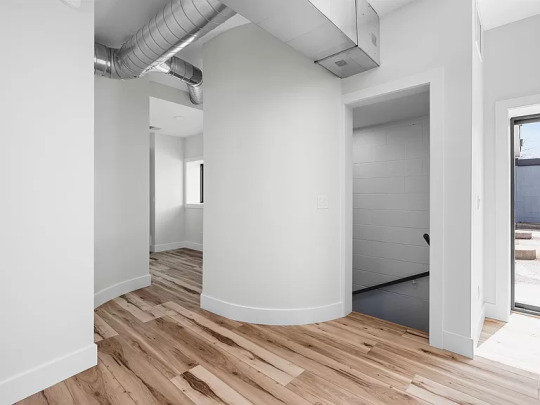
A lot of banks have this rounded column feature and they left it.
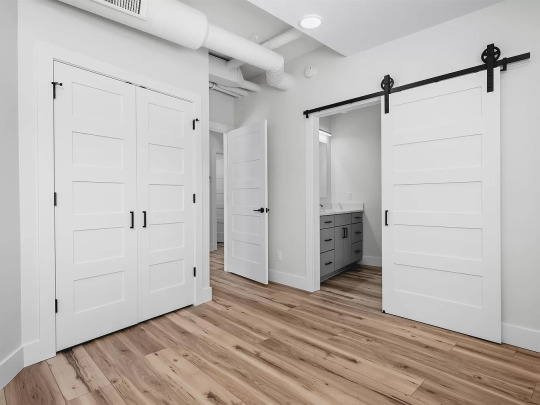
All bedrooms are like this- featureless, with a closet, sliding doors to an en-suite and industrial ceilings with pipes and things.
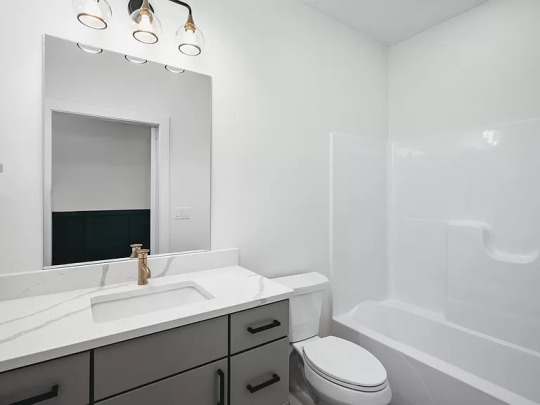
Small 3 pc. with plastic bath insert, no tile.

The primary bedroom has a walk-in closet and a big bank window.
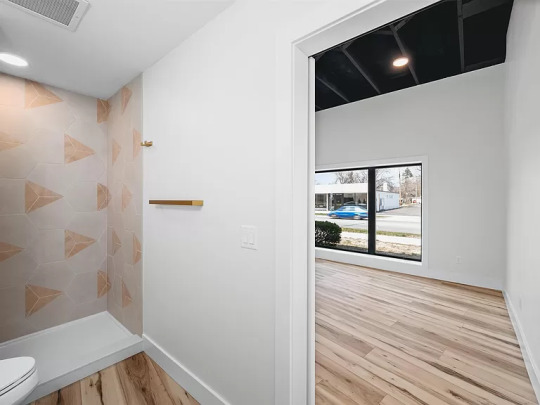

And, fancier tile in the shower.
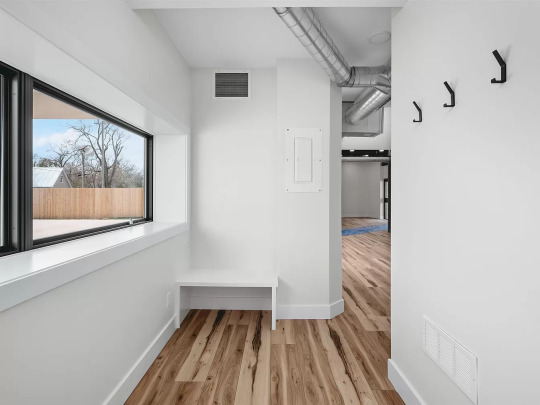
I think that this may be the drive-thru window room.

Spiral stairs to the basement.

Cinderblock half bath. Looks like the original door.
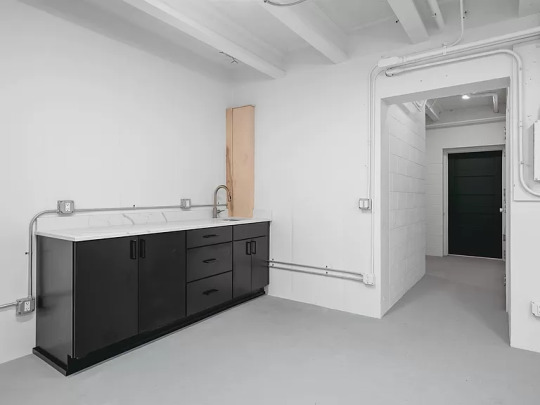
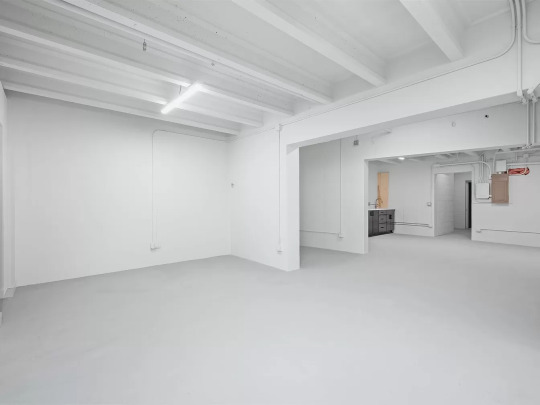
Large finished basement, no washer dryer, just a laundry room. Guess this flip was running way over budget.
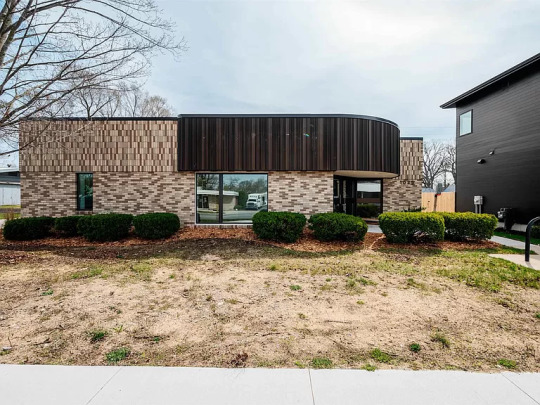
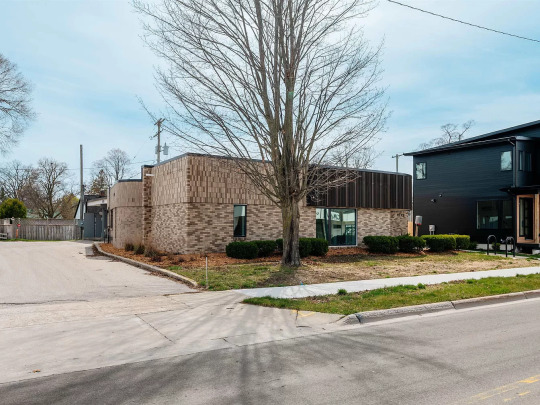
There's really no yard to speak of on the 6,969 sq ft lot, but there's plenty of parking.
https://www.zillow.com/homedetails/1028-E-8th-St-Traverse-City-MI-49686/339600007_zpid/
175 notes
·
View notes
Text
Just a study that didn't go according to plan
Pairing: yandere Optimus Prime x reader
That's the strangest offer you've ever gotten from Optimus. Sure you've seen a lot of things from that mech during your time in this world, but for him to offer you something like that?
“You're... what?” you raise an eyebrow, trying to understand: you're either deaf or specifically insane.
“I saw the look in your eyes, my Spark,” Optimus' mechanical voice, even in that tone, sounded like you were a stupid child and didn't understand the suggestion. “I've seen you looking at my body parts, so why not let yourself touch them?”
“Because then you'll fuck me.”
“I wouldn't call our bonding process such a crude word, but here's a chance.”
Manipulators grab the slender wrists, pulling them to Optimus' waist. He's ready to guide your palms himself, to direct where he'd be more interested, but if his Spark himself tries to explore it fully, Optimus will be inordinately pleased. More than glad.
So you get down to business, getting your little palms under the segments of armor. Delicately you touch him, afraid of the reaction you might elicit from Prime.
But the only thing you notice, when you finally touch the washer pipes, is how Optimus begins to move his antennae. It's an unusual reaction to your actions, but it only encourages you to continue.
But most desirable, and perhaps perverse, is your desire to touch your thighs. Too exposed to the eyes of outsiders. Maybe Optimus thought that less armor was always the key to success in battle?
You don't notice how your touch becomes more intimate: passing along the inside of your thigh, touching your groin plate. All of this is purely out of pure interest, and Optimus' reaction is not long in coming. The fur begins to overheat, venting systems louder and louder.
“Don't you dare,” you say, as you feel one manipulator lay on your shoulder, hoping to pull down the sleeve of your t-shirt.
“You're the one who brought the situation to the point where I dare.”
#transformers#optimus prime#reader insert#yandere#optimus#optimus x reader#optimus x you#transformers prime#optimus x human
69 notes
·
View notes
Text
transforming soffits reorganizing keys formalizing immersion joints justifying kick extractors advising aggregates managing elbows recasting connectors achieving aluminum trowels officiating disks exhibiting absolute spigots progressing coil hydrants jerry-building reflectors informing casters inventing rubber hoists performing wrenches judging chalk adapters upgrading ignition paths
regrowing flashing recommending ratchets approving barriers sweeping impact fillers sewing mirrors detailing collectors enforcing measures distributing systems presenting plugs interwinding registers piloting ash diffusers gathering cranks supplying eave pockets undertaking scroll stops accelerating straps designing fittings protecting diamond boilers logging downspouts correlating shingles uniting mallets qualifying electrostatic lifts sharing clamps obtaining circular fluids ranking foundation gauges sensing miter brackets originating space networks translating drills regulating guards selecting gable padding utilizing pellet dowels reconciling artifacts altering pulleys shedding space filters determining vents representing mortar remaking flash rakers supporting funnels typecasting rotary chocks expressing junctures resetting auxiliary vises professing strip treads inlaying matter trowels questioning drivers forming edge fittings sketching blanks overshooting spark breakers rewriting controls playing tunnels inventorying buttons enduring joint handles effecting ratchet bibbs unwinding couplings forsaking vapor conduits defining sockets calculating heaters raising grids administering tiles measuring resources installing ignition remotes extracting corners manufacturing ventilators delegating consoles treating mounting stones enacting jig deflectors intensifying alleys improvising cargo pinpointing bobs prescribing arc masonry structuring metal chucks symbolizing lathes activating plumb kits adapting coatings fixing channels expediting cordage planning compressors enlisting hangers restructuring keyhole augers shearing ridge hardware collecting reciprocating bolts maintaining corrugated dimmers whetting hole collars conducting mandrels comparing assets compiling sealants completing paths composing equivocation wheels computing dampers conceiving electrostatic treatment ordering cotter grates organizing ties orienting ladders exceeding materials targeting thermocouples demonstrating emery stock expanding latch bases training wardrobe adhesives overcomming[sic] fasteners streamlining storm anchors navigating springs perfecting turnbuckles verifying gate pegs arbitrating arithmetic lifts negotiating outlets normalizing strips building surface foggers checking key torches knitting grinders mowing planers offsetting stencils acquiring bulbs adopting rivets observing avenues ascertaining coaxial grommets slinging wing winches instituting circuit generators instructing wicks integrating pry shutters interpreting immersion lumber clarifying coils classifying wood bits closing cogs cataloging matter strips charting holders conceptualizing push terminals stimulating supports overthrowing shaft spacers quick-freezing connectors unbinding ground hooks analyzing eyes anticipating gateways controlling proposition rollers converting power angles coordinating staples correcting benders counseling joist gaskets recording gutter pipes recruiting drains rehabilitating rafter tubes reinforcing washers reporting guard valves naming freize sprues nominating rings noting straps doubling nailers drafting circuit hoses dramatizing flanges splitting framing compounds refitting stems interweaving patch unions placing sillcocks sorting slot threads securing mode cutters diverting catharsis plates procuring load thresholds transferring syllogism twine directing switch nuts referring time spools diagnosing knobs discovering locks dispensing hinges displaying hasps resending arc binders retreading grooves retrofitting aesthetics portals seeking stocks shrinking wormholes assembling blocks assessing divers attaining lug boxes auditing nescience passages conserving strikes constructing braces contracting saw catches serving installation irons recognizing fluxes consolidating fuse calipers mapping shims reviewing chop groovers scheduling lag drives simplifying hoists engineering levels enhancing tack hollows establishing finishing blocks
21 notes
·
View notes
Text
Things I do not understand about the design of my parents house
Bathroom
The shower head is mounted a foot too low. I'm around 5'10 and my eye level is right where the pipe comes out of the wall. (This is the case for every shower in the house) which means the water starts to hit you around your nipples
The toilet paper holder thing is in between the toilet and the tub and requires an uncomfortable reach, actually hard to use, and so no one does
None of the towel racks are within reach of the tub, there's one on the opposite end of the room and on the opposite side of the toilet
There is a fan - however it just vents into the attic - no actual vent was ever installed - also it's the scariest looking fan ever made, you can put your hand through it. The one downstairs was a complete afterthought, when we moved in there was just a random plug hanging out of the ceiling that went to the fan - which vents into the drop ceiling... of the basement
That's right the bathroom that's in a basement and has no window that can open and also used to have carpet in a house with no HVAC system has NO FUNCTIONAL VENT FAN
There is a window - it's just a regular window that faces the front lawn, so hopefully no one's out there. There's blinds on it, but they're mounted away from the window so you can still absolutely see in if you stand in the right spot
It has an absurd amount of countertop - not really a bad thing, but it's very overkill for a bathroom
The soap tile thing came off the wall and refused to be glued back on - so there's just a big duct tape patch there now
General
The entire downstairs is drop ceiling, yup like an office building.
On top of that the entire downstairs was originally only lit by single bulb fixtures, like for closets, just bare bulbs in a dark, damp basement - except bathrooms which were fluorescent lamps
The basement has a very uncomfortable hallway, it's about 3 feet wider than most hallways and is of course lit by one light bulb
There's a random angled wall here, so one of the rooms has a random angled wall for some reason
The house has TWO water heaters, a more common full size one and a smaller like half sized one. Guess which ones plumbed to the showers - that's right the small one, the big one is only connected to the kitchen sink, washer, and the nasty added on shower in the garage that no one has ever used.
Right - there's technically a third bathroom, it is IN the garage, i mean it's literally added on it's like a box that just juts out into the room. No one has used this bathroom as it is - like i said in the garage and thus smells of dust and mold and also there's no floor.
The floor plan is very odd, there's a BIG room and I mean big on both the first floor and the basement, and lots of tiny rooms, including the one my parents tried to move me too, which is quite frankly too small for a twin bed what you're supposed to do with a room that size I don't know.
There's no water filter of any kind here, not really a big deal, although the water is literally pumped out of the ground so uh sediment is in everything - like, the water filter for drinking has dirt in the top of it
The dust the downstairs of this house has dust like no other dust, the networking stuff is out in the garage where the dust is the worst, and it's killed 2 ethernet switches and a modem, it's this thick brown dust that - even though the house has been cleaned - will never go away
The deck - which is covered in plastic fake grass terf carpet and is nasty - is actually held up by a big iron rod that was clearly added much later than when the house was built, along with a much newer staircase
There's just a big gap in the wall on the side of the carport with a 5 foot drop - no one knows why it's there
Oh yeah also- the carport is on top of the garage - the garage is not accessible for cars, as it's on the basement level, so hearing a car roll ON TOP OF THE ROOM YOU'RE IN is really nerve-wracking
There were no lights of any kind originally installed in the back of the garage, it was literally permanently dark (the part under where the cars park btw
I mentioned the lack of HVAC - the house does has an oil-burning furnace - which smells of oil and makes a loud BANG every time it turns on and off
The stairs
The stairs don't really fit so there's no landing and instead there's a angled stair to rotate into the hall basically right across where the landing should be - I've tripped and nearly died on this a lot.
The stairs have only one light, at the top, which is almost impossible to reach to change bulbs, (you have to put a ladder at the top so you're at risk of falling down the entire stairwell if you fuck up) oh and this means the weird angled step is ALSO in the dark :)
The stairs extend out into the hall which is great for tripping over and dying on the concrete floor.
I'm living in the house of leaves
21 notes
·
View notes
Text
G.I HANGING CLAMP
G.I. (Galvanized Iron) hanging clamp is a type of mechanical device used to secure or support objects, typically in construction and electrical installations. Here's a description of the G.I. hanging clamp and how it is used:
Description
Material: Made from galvanized iron, which provides excellent resistance to corrosion and rust. This makes the clamp suitable for both indoor and outdoor use.
Design: The clamp usually features a C-shaped or U-shaped body with a tightening mechanism, such as a screw or bolt, to secure the clamp in place. Some models may also have additional components like washers or locking nuts for added stability.
Finish: The galvanized coating gives the clamp a shiny, metallic finish and ensures long-term durability by protecting the iron from environmental elements.
Construction and Engineering: In construction projects, these clamps can be used to support and secure various materials or components, such as pipes or ductwork. They are often employed to maintain alignment and stability in installations.
HVAC Systems: For heating, ventilation, and air conditioning systems, G.I. hanging clamps can be used to suspend and support ductwork and other components, ensuring they are properly positioned and supported.
General Mounting: In any application requiring the hanging or mounting of equipment, signage, or other items, G.I. hanging clamps can offer a reliable solution. Their robust construction allows them to handle moderate to heavy loads.

#alramiz#machines#hvac#wholesale#rewinding materials#thermostat#tools & safety#heater & element#are#acsparta#ARE#AL#RAMIZ#GIHangingClamp#MetalClamp#HeavyDutyClamp#IndustrialClamp#HangingClamp#ConstructionTools#GIClamp#BuildingHardware#SteelClamp#ClampingSolutions#ClampFittings#ClampingTools#PipeClamps
2 notes
·
View notes
Text
Regular Plumbing Maintenance
Plumbing is often an overlooked aspect of home maintenance until an issue arises. However, taking a proactive approach to plumbing care can save you time, money, and the hassle of dealing with emergencies. Regular plumbing maintenance is key to keeping your home’s water systems functioning efficiently and preventing unexpected problems. In this article, we’ll discuss why consistent plumbing upkeep is important and how you can easily integrate it into your home maintenance routine.
Preventing Leaks and Water Damage
One of the primary benefits of regular plumbing maintenance is the ability to prevent leaks. Even minor leaks can lead to significant water damage over time, resulting in costly repairs and potential health risks like mold growth. Regular inspections of your pipes, faucets, and fixtures can help you catch early signs of wear and tear before they escalate into bigger problems.Make it a habit to check for moisture or discoloration under sinks, around toilets, and in basements. If you notice any signs of leakage, address them immediately. Simple actions, such as replacing a worn washer or tightening a loose connection, can prevent more severe issues in the future.
Enhancing Water Efficiency
Regular plumbing maintenance also plays a crucial role in improving water efficiency. Over time, mineral deposits can build up in pipes, showerheads, and faucets, restricting water flow and decreasing efficiency. This not only impacts your water pressure but can also increase your water bills.To maintain water efficiency, periodically clean the aerators on your faucets and showerheads. If your home has hard water, consider installing a water softener to reduce mineral buildup. Additionally, check for running toilets, as they can waste a considerable amount of water. Often, simple adjustments to the flapper valve or float can fix this issue.
Extending the Lifespan of Your Plumbing System
Like any other part of your home, your plumbing system has a limited lifespan. However, regular maintenance can significantly extend its durability. For example, flushing your water heater regularly removes sediment that can reduce its efficiency. Similarly, inspecting and insulating exposed pipes can prevent freezing and bursting during colder months.By dedicating time to regular maintenance, you can avoid expensive repairs or replacements, ensuring that your plumbing system remains reliable for years to come.
Conclusion
Regular plumbing maintenance is a smart investment in the safety and longevity of your home. By routinely inspecting, cleaning, and maintaining your plumbing system, you can prevent leaks, enhance water efficiency, and extend the life of your pipes and fixtures. Don’t wait for a plumbing emergency to remind you of the importance of upkeep—incorporate these simple maintenance tasks into your routine and enjoy the peace of mind that comes with a well-maintained plumbing system.
2 notes
·
View notes
Text
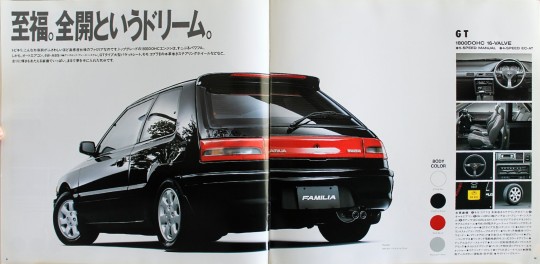
bliss. The dream of full throttle.
Tobikiri. It is a Familia with high-sensitivity specifications that deserves such an adjective. The top grade 1800DOHC engine is extremely powerful. In addition, it is full of equipment that adds brilliance to driving, such as automatic air conditioning, 4W-ABS (4-wheel anti-lock braking system), GT type large bucket seats, Momokobra leather-wrapped steering wheel, etc. I feel like I got my dream.
GT
1800DOHC 16-VALVE
05-SPEED MANUAL
4-SPEED EC-AT
Main equipment
(1) Momokobra Leather-wrapped steering wheel
(2) Auto air conditioner
(3) 4W-ABS (4-wheel anti-lock brake system
(4) Potenza 185/60R14 82H steel radial tire +14 inch Aluminum wheels
FM/AM electronic tuner + full logic cassetteDeck + 4 speakers GT type Large bucket seat
Roof spoiler with high mount LED stop lamp
Power window with one-touch mechanism
Power door lock
Split (60/40) folding rear seat
Dual exhaust pipes
Engine speed sensitive power steering
Aling tilt steering
One-touch intermittent rear wiper & washer rear package tray
Rear 3-point seat belt electrostatic Air ground button
(driver's seat/passenger seat) Side impact bar
15 notes
·
View notes
Text
Mastering the Art of Plumbing: Essential Tips and Tricks for Every Homeowner
Introduction: Plumbing is the circulatory system of your home, quietly working behind the scenes to keep everything flowing smoothly. From the moment you turn on the faucet to the flush of the toilet, plumbing plays a crucial role in our daily lives. However, when plumbing issues arise, they can quickly turn into a homeowner's worst nightmare. But fear not! With the right knowledge and a few handy tips, you can become a plumbing pro in no time.
Understanding Your Plumbing System: Before diving into fixing leaks or unclogging drains, it's essential to have a basic understanding of your home's plumbing system. Typically, plumbing consists of two subsystems: the water supply system and the drainage system. The water supply system brings fresh water into your home, while the drainage system removes wastewater.
Common Plumbing Issues and Solutions:
Leaky Faucets: A dripping faucet may seem like a minor annoyance, but it can waste a significant amount of water over time. Usually, a leaky faucet can be fixed by replacing a worn-out washer or O-ring. Remember to turn off the water supply before attempting any repairs.
Clogged Drains: Whether it's in the kitchen sink, bathroom shower, or toilet, clogged drains are a common plumbing problem. For minor clogs, a plunger or plumbing snake can often do the trick. Avoid using chemical drain cleaners as they can damage your pipes over time.
Running Toilet: A toilet that continues to run after flushing can waste gallons of water and inflate your water bill. In most cases, a running toilet is caused by a faulty flapper or fill valve. Replacing these components is relatively simple and can save you money in the long run.
Low Water Pressure: If your faucets are trickling instead of flowing, low water pressure may be the culprit. Potential causes include mineral buildup in the pipes, a faulty pressure regulator, or a partially closed shut-off valve. Checking these components and cleaning or replacing them as needed can help restore proper water pressure.
Frozen Pipes: During the winter months, exposed pipes are susceptible to freezing, which can lead to burst pipes and costly water damage. Insulating your pipes and keeping your home adequately heated can prevent this issue. If you suspect a frozen pipe, never use an open flame to thaw it—instead, use a hairdryer or heating pad.
DIY Plumbing Tips:
Invest in Quality Tools: A well-equipped toolbox is essential for any DIY plumber. Basic tools like wrenches, pliers, and pipe cutters will come in handy for most plumbing projects.
Know Your Shut-Off Valves: Familiarize yourself with the location of your home's main water shut-off valve, as well as individual shut-off valves for sinks, toilets, and appliances. Knowing how to turn off the water in an emergency can prevent water damage to your home.
Practice Preventative Maintenance: Regularly inspecting your plumbing system for leaks, corrosion, or other signs of damage can help catch potential issues before they escalate into major problems. Additionally, scheduling annual professional inspections can identify hidden issues early on.
Conclusion: While some plumbing tasks may require the expertise of a licensed plumber, many common issues can be resolved with a little DIY know-how. By understanding how your plumbing system works and learning some basic maintenance techniques, you can save time, money, and stress in the long run. So don't let plumbing problems dampen your spirits—empower yourself with knowledge and tackle them head-on!
2 notes
·
View notes
Text

'tis the season to download this image if you need it!
Image transcription of winter weather tips below the cut:
The leading cause of death during winter storms is transportation accidents. Preparing your vehicle for the winter season and knowing how to react if stranded or lost on the road are the keys to safe winter driving. Be ready before you drive!
Before you drive, have a mechanic check the following items on your car:
Battery
Antifreeze
Wipers/windshield washer fluid
Ignition system
Thermostat
Lights/flashing hazard lights
Exhaust System
Heater/Defroster
Brakes
Oil level (if necessary, replace existing oil with a winter grade oil or the SAE 10w/30 weight variety)
Take the proper precautions to outfit you and your car for winter driving:
Install good winter tires. Make sure they have adequate tread.
Maintain at least half a tank of gas at all times.
Plan long trips carefully. Listen to the radio or call 511 for the latest road conditions. Always travel during daylight and if possible, do not travel alone.
If you must go out during a winter storm, use public transportation.
Dress warmly. Wear loose-fitting, layered, lightweight clothing.
Keep the following items in your car at all times during the winter months:
Flashlights with extra batteries
First aid kit with a pocketknife
Necessary medications
Blankets and/or sleeping bags
Extra newspapers for insulation
Plastic bags (for sanitation)
Matches
Extra set of mittens, socks and a wool cap
Rain gear and extra clothes
Small sack of sand or kitty litter to generate traction under car wheels
Small shovel and other tools (pliers, wrench, screwdriver)
Jumper cables
Brightly-colored cloth (red) to use as a flag
Canned fruit/nuts and non-electric can opener
Bottled water
If You Get Trapped in Your Car During a Blizzard…
Stay in the car. Do not leave to search for assistance unless help is visible within 100 yards. You may become disoriented and lost in blowing and drifting snow.
Hang a brightly-colored cloth on the radio antenna and raise the hood to draw attention.
Do minor exercises to keep up circulation. Clap hands and move arms and legs. Try not to stay in one position for too long. If more than one person is in the car, take turns sleeping.
Avoid overexertion. Cold weather puts an added strain on the heart. Unaccustomed exercise like snow shoveling or pushing a car can bring on a heart attack or make other medical conditions worse.
Run the engine occasionally to keep warm. Turn the engine on for about 10 minutes each hour. Run the heater and turn on the dome light while the car is running. Beware of carbon monoxide poisoning. Keep the exhaust pipe clear of snow, and open a downwind window slightly for ventilation.
For warmth, huddle together.
Frostbite and Hypothermia
Frostbite is a severe reaction to cold exposure that can be permanently damaging. Symptoms include: loss of feeling and a white or pale appearance in fingers, toes, or nose and earlobes.
Hypothermia can be brought on when the body temperature drops to less than 90°F. Symptoms include uncontrollable shivering, slow speech, memory lapses, stumbling, drowsiness, and exhaustion.
If frostbite or hypothermia is suspected, begin warming the person slowly and seek immediate medical assistance. Warm the person’s trunk first. Use your own body heat to help. Arms and legs should be warmed last because stimulation of the limbs can drive cold blood toward the heart and lead to heart failure. Put the person in dry clothing and wrap their entire body in a blanket.
Never give a frostbite or hypothermia victim something with caffeine or alcohol in it. Caffeine, a stimulant, can cause the heart to beat faster and alcohol, a depressant, can slow the heart. Both can hasten the ill effects of cold body temperatures.
3 notes
·
View notes
Text
10 Common Home Repairs Every NJ Homeowner Faces (And How to Fix Them)

Key Takeaways
Proactive home maintenance can save NJ homeowners thousands in unexpected repairs.
Knowing DIY fixes—and when to call a pro—helps you avoid stress and costly mistakes.
Certain repairs, like flooring and bathroom upgrades, offer a high return on investment.
Ever had that moment when a faucet starts dripping, a window won’t budge, or a mystery stain appears on the ceiling—right when you’re least ready for it? If so, you’re in good company. New Jersey homes, thanks to wild weather swings and an older housing stock, seem to have a sixth sense for breaking at the most inconvenient times.
Surprising fact: In 2024, nearly half (46%) of homeowners nationwide spent over $5,000 out-of-pocket on unexpected repairs—a sharp jump from the year before (Hippo Insurance). It’s a pricey reminder: home repairs aren’t just background noise—they can hit your wallet hard if you’re not prepared.
Let’s break down not just what breaks in a typical NJ home, but why it breaks (hint: blame the weather and natural wear-and-tear), and what you can actually do about it. Whether you’re deciding if you need a handyman solution in New Jersey or want practical DIY tips, you’re about to get an actionable fix-it roadmap.
Why Home Repairs Matter So Much in New Jersey
Seasonal and Environmental Challenges
Living in New Jersey means facing snowstorms, heavy rain, hurricanes, a sizzling summer sun, and plenty of freeze-thaw headaches. Combine climate with homes that often date back decades, and you’re facing:
Cracked foundations and roofs from shifting soils and freezes.
Plumbing leaks due to pipe expansion and contraction.
Aging electrical and HVAC systems exposed to moisture and humidity.
Ever wondered how to deal with a surprise water leak? Check out our guide to water leak management for step-by-step advice.
The Real Cost (and Stress) of Home Maintenance
The average New Jersey homeowner spends about $2,458 a year tackling 6–7 home repair projects (Angi). And yet, more than 65% say they struggle to find trustworthy home repair professionals (Hippo Insurance). The result? Delays, stress, and often, even bigger repair bills.
Project Type
Average Cost (NJ)
DIY Possible?
Plumbing Fixes
$200 - $900
Sometimes
Drywall Repair
$250 - $750
Yes
Flooring Repairs
$300 - $1,200
Sometimes
Electrical Work
$150 - $900
Rarely
Painting
$150 - $600
Yes
The Top 10 Most Common Home Repairs in NJ (And How to Fix Them)
1. Leaky Faucets and Running Toilets
These are classic culprits. Hard water and aging washers often cause slow drips and phantom flushes. Here’s what you can do:
DIY Fix: Turn off the water, replace worn washers or flapper valves, and tighten fittings.
Call a Pro: If the leak persists or turns into a flood, reach out to a local plumber.
2. Cracked or Damaged Drywall
Between wall hangings, settling foundations, and the occasional bump, drywall damage is all but guaranteed.
Step-by-Step Drywall Patch:
Clean and sand the damaged area.
Apply a patch (or joint compound for smaller holes).
Smooth, let dry, sand again, and repaint for a seamless finish.
For tricky jobs, experienced help is just a click away: drywall service pros.
3. Faulty Electrical Outlets and Light Switches
Flickering lights or warm outlets usually spell trouble. Electrical DIY can be risky, so if you’re not sure, play it safe.
Basic Check: Tighten faceplates, test with a ground tester.
Professional Help: If there’s buzzing, burning smell, or tripped breakers, stop and contact licensed electrical experts.
4. Sticking or Damaged Doors
NJ’s humidity and settling homes often lead to doors that scrape or won’t latch. Here’s how to handle it:
DIY: Tighten screws, adjust hinges, lubricate moving parts.
Expert Repair: Warped frames? Check out door repair services.
5. Drafty or Broken Windows
Drafts can cost big on your energy bill and kill your climate comfort. If you notice a cold spot or sticky window:
Quick Fix: Try weatherstripping or caulking cracks.
Upgrade: Modern windows can save up to 15% on energy bills (WorldMetrics). Consider window installation services for lasting ROI.
6. Roof and Gutter Leaks
The Garden State weather puts roofs and gutters to the test.
DIY Tip: Clear out leaves, check for missing shingles, and patch minor leaks.
When to Call Pros: Water stains or persistent leaks mean it’s time for a handyman solution in New Jersey with roof experience.
7. Peeling or Fading Paint
Paint flakes off with moisture, sun exposure, and age.
Quick Touch-Up: Sand peeling spots, prime, and paint.
Whole Room Do-Over: Quality prep matters—clean, patch, and prime before you roll. Need perfection? Painting services can refresh your home inside and out.
8. Damaged or Squeaky Flooring
Squeaks, chips, and warps happen, especially with wood and laminate.
Simple Fixes: Secure loose boards with hidden nails or glue, sprinkle talc for squeaks.
Upgrade Payoff: Hardwood refinishing returns an average of 147% ROI (Architectural Digest). If it’s time, get professional flooring help.
9. Clogged Drains or Sewer Backups
Here’s the dirty truth—hair, grease, and roots are the usual suspects. Use plungers, try enzyme cleaners, but beware:
DIY: Plunge and use natural drain cleaners.
Call for Backup: Slow drains or weird odors require a skilled plumber.
10. Deck and Exterior Wood Rot
NJ’s wet seasons mean deck boards and outdoor steps are prone to softening, mold, and splintering.
DIY: Replace rotted boards, apply sealant, and stain for protection.
Safety First: If you suspect structural rot, let a pro inspect.
People Also Ask
What are the most expensive home repairs in NJ?
Big-ticket items include roof replacement, foundation repair, and full HVAC system upgrades. These often require professional help due to scope and safety.
How often should I inspect my home for repairs?
A seasonal walk-through (spring and fall) helps you catch issues early and prevents emergencies.
Can I do electrical repairs myself?
Stick to minor fixes, like changing a plate or replacing a bulb. For wiring or circuit breaker issues, always bring in a licensed electrician, as mistakes can cause fires or code violations.
Do DIY repairs affect my home’s value?
Well-done DIY can be a plus. But shoddy work (especially plumbing, electrical, or structural) may scare off buyers and fail inspections.
What repairs have the highest ROI in New Jersey?
Wood flooring upgrades, kitchen/bath remodels, and energy-efficient window replacements routinely top the list (Architectural Digest, WorldMetrics).
Why You Can’t Ignore Home Repairs
Delaying repairs isn’t just risky—it gets expensive. Nearly 1 in 5 Americans caused extra damage to their homes through neglect, averaging $840 just to fix what was left too long (Frontdoor). A minor leak can morph into a major mold problem or a cracked sidewalk into a trip hazard.
Bullet List: Consequences of Ignoring Repairs
Higher energy bills from drafty windows/doors
More expensive, invasive fixes later on
Health risks from mold, electrical trouble, or water damage
Lower resale value and more hassle come moving day
Smart Upgrades: High-ROI and Energy-Efficient Repairs
Some repairs pay you back by boosting your home’s value and slashing costs:
Wood floors: Refinish or replace for up to 147% ROI
Bathroom remodels: Average 70% ROI (WorldMetrics)
New windows/doors & better insulation: Save up to 15% yearly on energy bills (WorldMetrics)
A well-maintained home can sell for 10% more when it’s time to move (Thumbtack Blog), making upkeep one of the smartest investments you can make.
Choosing the Right NJ Handyman or Contractor
Not all repair pros are created equal. Here’s what to look for:
Checklist: Vetting Home Repair Companies
Licensed and insured in New Jersey
Strong local reviews
Transparent, up-front quotes
Familiarity with NJ building codes and permit requirements
Given that 65% of homeowners struggle to find reliable help (Hippo Insurance), take time to check credentials and ask for referrals. Unsure where to start? Check our Home Repair Services in West Long Branch NJ page for guidance.
DIY or Pro? Small projects (painting, caulking, patching drywall) are DIY-friendly with some research. Electrical, major plumbing, or anything involving your roof, foundation, or safety—leave that to the experts.
Maintenance Planning Like a Pro
Don’t wait for disaster. Create a year-round home maintenance checklist:
Season
Maintenance Tasks
Spring
Clean gutters, inspect roof, touch up paint, test sump pump
Summer
Deck repairs, AC servicing, caulk windows, mow lawn
Fall
Rake leaves, check heating system, inspect insulation
Winter
Pipe insulation, clear icicles, check for drafts
Budgeting & Scheduling Tips
Spread projects through the year.
Get off-season deals (e.g., painting in winter).
Review local blogs and online maintenance guides; our HandyPro NJ Blog is a great start.
Make Your Next Home Repair (Surprisingly) Stress-Free
A little planning goes a long way: by spotting issues early, budgeting smartly, and knowing when to call in the pros, you save money and protect your biggest investment. Plus, well-maintained homes are safer, more energy efficient, and sell for 10% more.
Ready for hands-on help or just want an expert’s opinion? Contact us at HandyPro Home Services NJ. Let’s turn that “fix-it” list into a “done” list.
FAQs
1. How do I prioritize which home repairs to tackle first? Start with anything affecting safety (electrical, roof, leaks), then work down to comfort and cosmetics. Use a checklist to rank by urgency and budget impact.
2. What tools should every NJ homeowner have for basic repairs? A good tool kit includes a hammer, screwdrivers, pliers, measuring tape, utility knife, adjustable wrench, and a cordless drill—plus safety gear.
3. Are there any home repairs NJ law requires to be done by licensed pros? Yes—electrical, plumbing beyond fixture replacements, roofing, and structural work usually require licensed professionals for code compliance and insurance.
4. How much can DIY home maintenance really save me over time? Smart DIY upkeep can save hundreds annually, especially on projects like painting, patching, or basic landscaping. But always balance savings with risk!
5. Where can I find reliable home repair advice and resources specific to New Jersey? Local experts like HandyPro NJ’s Blog provide region-specific tips, seasonal guides, and a directory of vetted pros.
0 notes
Text
How a Home Warranty Complements Homeowner’s Insurance
When you buy a home, your first priority is protecting it. Most people begin with homeowner’s insurance—an essential tool that covers major damage from fire, storms, or theft. But as any homeowner quickly learns, this insurance doesn't help when everyday wear and tear causes your furnace to fail or your dishwasher to stop working. That’s where a home warranty steps in.
A home warranty complements your homeowner’s insurance by filling the gaps—covering the systems and appliances that standard policies ignore. Together, they offer comprehensive protection for your property, your wallet, and your peace of mind.
What Does Homeowner’s Insurance Cover?
Homeowner’s insurance is designed to protect you against financial loss from specific, unexpected events. These usually include:
Fires and smoke damage
Weather-related damage (hail, lightning, wind)
Theft and vandalism
Certain types of water damage (like burst pipes)
Liability protection if someone is injured on your property
While incredibly important, homeowner’s insurance is focused on structural damage and liability. It does not cover your home’s mechanical systems or appliances if they fail due to regular use or age.
That means if your HVAC system breaks down during a heatwave or your refrigerator stops cooling, your insurance policy likely won’t help.
What Does a Home Warranty Cover?
A home warranty is a service contract that covers the repair or replacement of your home’s major systems and appliances due to normal wear and tear. This includes:
Heating, ventilation, and air conditioning (HVAC)
Electrical and plumbing systems
Kitchen appliances (refrigerator, oven, dishwasher
Laundry appliances (washer and dryer)
Water heaters and more
Unlike insurance, which focuses on sudden disasters, a home warranty protects you from the inevitable breakdowns that come with daily living.
How Do They Work Together?
Think of homeowner’s insurance and a home warranty as two pieces of the same puzzle.
Homeowner’s insurance is your protection against major disasters.
A home warranty is your safeguard against everyday wear.
Here’s an example: Imagine a lightning strike damages your electrical wiring and fries your refrigerator.
Your homeowner’s insurance would cover the structural damage and possibly some appliance loss due to the lightning.
Your home warranty would kick in if your refrigerator simply stopped working due to age or mechanical failure—something insurance won’t cover.
Together, these policies provide full-spectrum coverage: from fire to faulty fuses.
Financial Protection That Makes Sense
Home systems and appliances are expensive to repair or replace. Just take a look at some average costs:
HVAC replacement: $5,000 – $12,000
Water heater repair: $500+
Oven replacement: $1,000+
A home warranty typically costs between $400 and $700 per year, with predictable service call fees. This makes it easier to budget for the unexpected. It’s also one of the reasons why so many people are searching what is the best home warranty—they want to avoid surprise expenses and unreliable repair services.
With a good home warranty, you're not just buying coverage—you're gaining access to a trusted network of service providers and guaranteed repairs.
Peace of Mind for Every Homeowner
If you’re a first-time homebuyer, a home warranty can remove much of the stress that comes with managing a home. You don’t have to scramble to find a plumber or technician. If something breaks, you file a claim, pay the service fee, and the warranty company handles the rest.
For experienced homeowners, especially those with older systems and appliances, a home warranty becomes even more valuable. As your home ages, so does everything in it. Having backup protection can extend the life of your home—and your savings account.
What Is the Best Home Warranty?
If you're wondering what is the best home warranty, the answer depends on your needs, but here are a few key factors to look for:
Comprehensive Coverage Look for plans that include HVAC, plumbing, electrical, and appliances. Optional add-ons like pool or septic system coverage are a bonus.
Transparent Pricing Avoid providers with confusing terms or hidden fees. Clear service fees and straightforward annual pricing make a big difference.
Reputation and Reviews Choose a company with strong customer reviews, fast response times, and a track record of honoring claims.
Licensed Technicians The best home warranty companies only work with vetted, licensed professionals to ensure quality repairs.
Customer Service 24/7 claims support and responsive service teams make the process hassle-free when something breaks down.
Companies like ServicePlus Home Warranty are well-regarded for offering all of the above—making them a smart choice for homeowners who want both value and reliability.
Final Thoughts: Why You Need Both
Owning a home is rewarding, but it's also a long-term commitment with ongoing responsibilities. Combining homeowner’s insurance with a home warranty gives you comprehensive protection from both unexpected disasters and everyday breakdowns.
Homeowner’s insurance gives you confidence in the face of major emergencies.
A home warranty keeps your home running smoothly day in and day out.
Together, they make homeownership less stressful, more predictable, and far more affordable.
So if you’re ready to truly protect your home and everything in it, don’t just stop at insurance. Consider exploring your options and find what is the best home warranty plan for your household’s needs.
0 notes
Text
Plumbing Problems? Trust Homeglow – Your Local Experts in Rotherham
Fast and Efficient Plumbing Services You Can Rely On
When a pipe bursts, a boiler stops working, or your bathroom is flooded, the last thing you want is to wait days for a fix. At Homeglow Plumbing & Gas Services Ltd., we understand that plumbing emergencies can disrupt your entire day—and sometimes even damage your property. That’s why we offer same-day service by reliable plumbers in Rotherham, South Yorkshire, to ensure your home stays comfortable and safe.
We’re not just fast—we’re thorough. Every job we handle is done with attention to detail and long-lasting results in mind. Whether it’s replacing a worn washer, repairing a leaking radiator, or diagnosing boiler issues, we’ve got the experience and skills to do it right the first time.
What Makes Our Services Stand Out?
We go beyond simple repairs. We offer full-service plumbing, from installations to maintenance, for both domestic and small commercial needs. Our team of Rotherham-based plumbing and heating experts are all fully certified, Gas Safe registered, and equipped with the latest tools. That means less guesswork, faster repairs, and safer outcomes.
For homeowners upgrading their bathrooms or kitchens, we also provide expert plumbing designs and installations. Need help choosing a new boiler or improving energy efficiency? We’ll walk you through the best options for your budget and home setup.
Our clear pricing structure ensures you never pay more than necessary. Plus, we provide free, no-obligation quotes so you can plan your repairs or upgrades with confidence.
A Local Team You Can Trust
At Homeglow Plumbing & Gas Services Ltd., we’re proud to be known as dependable local plumbers in South Yorkshire, with a strong reputation for quality and trust. We treat every home we visit as if it were our own—clean, respectful, and professional from start to finish.
Over the years, we’ve served hundreds of happy clients across Rotherham and surrounding towns. Many of them continue to call us for yearly servicing, upgrades, and emergency help. They know we’re always just a phone call away, ready to lend a hand when it matters most.
If you’re tired of unreliable plumbers and confusing invoices, switch to a team that puts you first. Choose Homeglow Plumbing & Gas Services Ltd. and experience the difference real professionalism makes.
Book Now and Let Us Take the Pressure Off
Don’t let a plumbing issue turn into a costly disaster. Contact us today and get the fast, honest help you deserve. Whether you’re facing a leak, need a new heating system, or simply want a safety check, our qualified plumbers in Rotherham, South Yorkshire are ready to help.
0 notes
Text
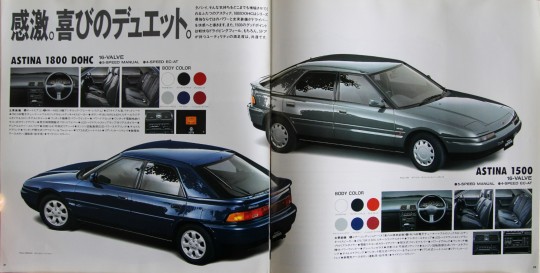
Deep emotion. A duet of joy.
Tanoshii. Two Astinas that amplify such feelings to the limit. The 1800DOHC is the strongest in the series, and the power and full equipment will lead the driver to pleasure. In addition, 1500 good points is a light driving feel. Of course, the utility satisfaction of the 5-door is common.
ASTINA 1800 DOHC
16-VALVE
●5-SPEED MANUAL
4-SPEED EC-AT
Main equipment Auto air conditioner AW-ABS (4-wheel anti-lock braking system) GT-type large bucket seats ● FM/AM electronic tuner + full logic set deck + 4 speakers ● Potenza 185/60R14 82H steel radial tires and 14-inch aluminum wheels ● One-touch - Power window with mechanism - Power door lock - One-touch electric retractable remote control color door mirror - Time-adjustable front wiper - Rear spoiler with LED high mount stop lamp - Dual exhaust pipe Steering tilt steering ●One-touch intermittent rear wiper and washer ●Rear 3-point seat belt ●Rear package tray Static electricity Ground button (driver's seat/passenger seat) ●Side impact bar
BODY COLOR
clear white
Brilliant Black
Blaze Red
silent silver metallic
Bay blue
Passion Rose Mica
ASTINA 1500
16-VALVE
5-SPEED MANUAL
4-SPEED EC-AT
Main equipment Air conditioner (standard equipment for AT cars only) 2FM/AM electronic tuner + full logic cassette deck + 4 speakers 175/70R13 82S steel radial tires Full wheel cap LED high mount stop run Power window glass with structure Split (64) Retractable rear seat Engine speed sensitive power steering
Electric remote-controlled color door mirror Intermittent front wiper Power door lock one-touch device
●Tilt steering ●One-touch intermittent rear wiper and washer ●Rear 3-point seat belt ●Rear package tray Static electricity ground button (driver's seat/passenger seat) Side impact bar
8 notes
·
View notes
Text
Just how to Fix a Dripping Showerhead and a Dripping Central heating boiler
Exactly how to Take Care Of a Dripping Showerhead and a Dripping Boiler
Handling a leaking showerhead or boiler can be an actual inconvenience, however do not fret - we have you looked after. Whether it's a relentless drip or a consistent stream, the trick is to determine the source and address it promptly. With the ideal steps and a little bit of knowledge, you'll have those pesky leakages fixed in no time. So, allow's plunge in and reveal the keys to restoring your home's pipes back to its former magnificence. By the time we're done, you'll be the resident plumbing professional, thrilling your loved ones with your newfound abilities.
Trick Takeaways
Inspect the showerhead for visible damages, mineral accumulation, or loose links and change or cleanse the parts as required.
Take a look at boiler pipes and links for cracks, loose installations, or low stress, and address any issues to identify and repair the leak.

youtube
Take apart the showerhead, change used washing machines, and reconstruct it properly to prevent future leaks.
Accessibility the boiler elements, identify the leak source, and use plumbing technician's tape or sealer during reassembly to stop future leakages.
Follow security precautions, such as putting on safety gear and making sure the boiler is powered off and cooled down before beginning any type of repairs.
Identifying a Dripping Showerhead
To identify a leaking showerhead, first turn on the water and evaluate the showerhead closely for any type of noticeable signs of damage or wear. Depending on the sort of showerhead you have actually - taken care of, portable, or rainfall - the reasons for a drip can vary. Typical causes consist of a damaged washing machine, a build-up of natural resource, or a damaged valve.
If the showerhead is trickling from the base, the problem is likely a worn-out washing machine or a loose connection between the showerhead and the shower arm. Tightening the link or changing the washer may dealplumber.co.uk fix the issue.

If the drip is coming from the face of the showerhead, mineral build-up is possibly the offender. Attempt saturating the showerhead in vinegar to get rid of the down payments. For a portable showerhead, the concern might be a faulty valve system that needs substitute.
Determining the particular cause of the drip is the very first step in fixing your showerhead. With a little troubleshooting, you can obtain your shower back to a constant, drip-free flow.
Dismantling the Showerhead
When you've identified the source of the drip, it's time to take apart the showerhead. Loosen the showerhead from the shower arm, making sure not to shed any small parts. Thoroughly check out each element to identify the necessary fixings.
Showerheads can be found in numerous kinds, including taken care of, portable, and rainfall designs. No matter the kind, the disassembly procedure is comparable. Start by eliminating the external casing, which may be protected with a keeping ring or screws. This will expose the inner parts, such as the spray nozzles, gaskets, and circulation restrictor.
Evaluate the nozzles for any kind of mineral buildup or damage that could be creating the drip. If the nozzles are blocked, you can attempt saturating them in vinegar or utilizing a little brush to eliminate the deposits. Change any used or damaged gaskets to guarantee a
0 notes
Text
Regular Cleaning and Maintenance for Optimal Performance of Evacuated Tube Solar Collectors
Although evacuated tube solar collectors are known for their low maintenance requirements, regular cleaning and maintenance are still essential to ensure that the system operates efficiently over its lifespan. Proper upkeep ensures that the system continues to absorb the maximum amount of sunlight and delivers reliable performance, especially during times of high demand. Here’s a guide to the best practices for cleaning and maintaining your evacuated tube solar collectors:

1. Cleaning the Evacuated Tubes
Dirt, dust, and debris can accumulate on the surface of the evacuated tubes over time, blocking sunlight and reducing the system’s efficiency. Regular cleaning is necessary to ensure that the system can absorb as much sunlight as possible.
How to Clean the Tubes:
Frequency: Cleaning should be done every 6-12 months depending on environmental factors. Areas with high dust, pollen, or industrial pollution may require more frequent cleaning.
Cleaning Method:
Use a soft cloth or sponge to gently wipe the surface of the glass tubes.
If the tubes are heavily soiled, use mild soap and warm water. Avoid harsh chemicals that could damage the glass or coatings.
For areas with more stubborn dirt, use a non-abrasive brush to avoid scratching the surface.
Pressure washers or hoses can be used for cleaning, but avoid using high pressure directly on the tubes to prevent potential damage.
Benefit: Regular cleaning ensures that dirt and debris don’t obstruct sunlight, maximizing the system’s ability to absorb solar energy and maintain its efficiency.
2. Remove Snow or Ice (If Applicable)
In cold climates, snow and ice can build up on the evacuated tubes, blocking sunlight and reducing the system’s ability to heat water. Although the vacuum insulation of evacuated tubes prevents freezing, snow accumulation can still limit their performance.
How to Remove Snow:
Light snow: Snow will often slide off the tubes naturally due to the angle of the collectors and the smooth glass surface. However, if it accumulates, it can be gently removed by hand.
Heavy snow or ice: Use a soft broom or a non-abrasive tool to carefully brush off the snow. Be cautious when using ladders, and avoid harsh tools that could crack or damage the glass.
Benefit: Clearing snow from the tubes ensures that solar energy absorption isn’t obstructed during the winter months, maintaining consistent performance even in snowy conditions.
3. Inspecting the System Regularly
Regular inspections are essential to identify any potential issues early and to ensure that the system continues to operate efficiently. While evacuated tube solar systems are low-maintenance, periodic checks can help catch problems before they become costly repairs.
Inspection Checklist:
Glass Tubes: Check for cracks or damage. While the borosilicate glass used in evacuated tubes is strong and resistant to thermal shock, it is still important to ensure that no tubes are cracked or compromised.
Heat Pipes: Ensure that the heat pipes are intact and functioning. If you notice any leaks or damage, they may need to be replaced.
Connections: Inspect the connections between the tubes, heat pipes, and the storage tank to ensure that there are no leaks or loose fittings.
Storage Tank: Make sure the storage tank is well-insulated and free from any rust or corrosion. A well-insulated tank will help maintain the temperature of the heated water and reduce energy loss.
Benefit: Routine inspections help ensure that the system is in optimal condition and free from defects that could reduce performance or cause damage.
4. Check for Proper Functioning of the Temperature Control and Valves
Evacuated tube solar systems typically include temperature control systems and pressure relief valves to regulate the temperature and pressure inside the system. Ensuring these components are functioning correctly is important for maintaining system safety and performance.
Key Checks:
Thermostatic Controls: Ensure that the system’s thermostat is operating correctly, and the temperature sensors are properly calibrated to avoid overheating.
Pressure Relief Valve: Verify that the pressure relief valve is functioning properly to avoid pressure build-up in the system, which could damage the system or lead to leaks.
Circulation Pump: If your system includes a circulation pump, check that it is working efficiently and that the flow rate is sufficient to circulate water between the collectors and the storage tank.
Benefit: Regular checks of temperature control and valves ensure the system operates safely and efficiently, preventing issues like overheating or water damage.
5. System Flushing and Descaling (Occasionally)
Over time, mineral deposits from hard water can build up in the pipes or heat exchanger within the system, reducing its efficiency. Flushing and descaling the system can help maintain optimal heat transfer and prevent blockages.
How to Flush and Descale the System:
Frequency: Flushing the system is typically only necessary every 2-5 years, depending on the water quality in your area.
Descaling: Use descaling agents specifically designed for solar water heating systems to remove mineral buildup. Follow the manufacturer’s instructions to prevent damage to the pipes or components.
Flush the System: To flush the system, close the water supply, disconnect the system from the main water lines, and allow the water to drain. Then, reconnect and refill the system with clean water to remove any remaining debris.
Benefit: Flushing and descaling maintain efficient heat transfer, ensuring that the system continues to operate at its highest efficiency over time.
6. Professional Service (Every Few Years)
While regular cleaning and inspections can be done by the homeowner or user, it’s a good idea to have the system professionally serviced every few years. A technician can check the system’s performance, ensure that it’s functioning at optimal levels, and make any necessary repairs or adjustments.
What Professional Service Includes:
Detailed inspection of all system components.
Cleaning and descaling of the system if necessary.
Testing of the temperature control system, pressure relief valve, and heat pipes.
Replacement of worn or damaged components.
Benefit: Professional servicing ensures that your system remains in top condition, extending its lifespan and preventing expensive repairs.
Regular cleaning and maintenance are essential to ensure the continued optimal performance of your evacuated tube solar collectors. By following simple tasks like cleaning the tubes, checking the system for damage, and ensuring the temperature control and valves are functioning, you can maximize the system's efficiency, extend its lifespan, and avoid costly repairs. With minimal maintenance efforts, evacuated tube solar collectors can provide reliable, efficient hot water for many years, making them a great long-term investment. For more info contact Solar Water Heater Supplier in UAE or call us at +971 4 2522966.
0 notes
Text
Comprehensive Guide to Plumbing Installation, Drain Cleaning, and Repairs
A functional plumbing system is essential for every home, ensuring clean water supply and efficient waste removal. Proper plumbing installation, regular drain cleaning, and timely repairs are crucial to maintaining this system's efficiency and longevity. This guide delves into these aspects, offering insights into best practices and the benefits of professional services.

🏗️ Plumbing Installation: Laying the Foundation
The foundation of any plumbing system lies in its installation. Whether renovating an existing space or constructing a new one, ensuring proper installation is vital.
Key Components:
Pipes and Fittings: Materials like PVC, copper, and PEX are commonly used, each with its advantages.
Fixtures: Toilets, sinks, bathtubs, and showers must be installed with precision to prevent leaks and ensure functionality.
Water Heaters: Proper installation ensures energy efficiency and consistent hot water supply.
Sump Pumps: Crucial for preventing basement flooding by directing water away from the foundation.
Professional plumbers possess the expertise to handle these installations, ensuring compliance with local codes and preventing future issues.
🧼 Drain Cleaning: Preventing Blockages and Odors
Regular drain cleaning is essential to prevent clogs, foul odors, and potential water damage.
Methods:
Snaking: A flexible auger is used to dislodge blockages.
Hydro Jetting: High-pressure water streams clear stubborn debris and buildup.
Chemical Cleaners: While effective, they should be used sparingly to avoid pipe damage.
It's advisable to consult with professionals to determine the most suitable method for your plumbing system.
🔧 Plumbing Repairs: Addressing Common Issues
Over time, plumbing systems may develop issues that require prompt attention.
Common Problems:
Leaky Faucets: Often caused by worn-out washers or seals.
Running Toilets: May result from faulty flappers or fill valves.
Low Water Pressure: Can be due to mineral buildup or pipe corrosion.
Clogged Drains: Often caused by grease, hair, or foreign objects.
Timely repairs can prevent more significant issues and save on costly replacements.
🧪 Advanced Techniques: Sewer Camera Inspections
Modern technology has revolutionized plumbing diagnostics.
Benefits:
Non-Invasive: No need for digging or destruction.
Accurate Diagnosis: Identifies issues like cracks, blockages, or root intrusions.
Cost-Effective: Prevents unnecessary repairs by pinpointing exact problems.
Sewer camera inspections are particularly useful for persistent drainage issues or when planning major repairs.
🧰 Choosing the Right Plumbing Service
Selecting a reputable plumbing service ensures quality work and peace of mind.
Considerations:
Experience: Look for companies with a proven track record.
Licensing and Insurance: Ensures compliance with local regulations and protection against damages.
Customer Reviews: Feedback from previous clients can provide insights into service quality.
Warranty: A warranty on services indicates confidence in their work.
🧼 DIY Tips for Basic Maintenance
While professional services are essential, homeowners can perform basic maintenance to prolong the life of their plumbing systems.
Tips:
Regularly Clean Drains: Use natural cleaners like baking soda and vinegar.
Avoid Chemical Drain Cleaners: They can damage pipes over time.
Check for Leaks: Inspect visible pipes and fixtures periodically.
Monitor Water Pressure: Ensure it's within the recommended range to prevent strain on pipes.

🏡 Conclusion:
A well-maintained plumbing system is crucial for the comfort and safety of your home. Regular installations, cleaning, and timely repairs can prevent major issues and extend the lifespan of your plumbing infrastructure. By staying proactive and consulting with professionals when needed, homeowners can ensure a reliable and efficient plumbing system.
1 note
·
View note